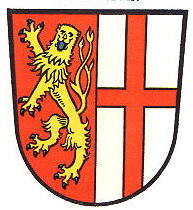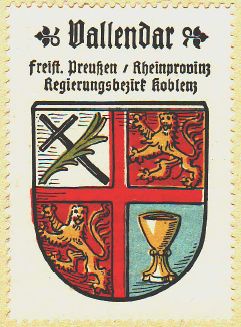Vallendar: Difference between revisions
Knorrepoes (talk | contribs) m (Text replace - "[[Literature" to "{{media}} [[Literature") |
Knorrepoes (talk | contribs) m (Text replace - "The arms in the Kaffee Hag albums +/- 1925 " to "The arms by Hupp in the Kaffee Hag albums +/- 1925 ") |
||
| Line 24: | Line 24: | ||
Hupp showed the arms as used before 1909, showing the cross, the lion, a chalice and in the first quarter a cross and a palmyre: | Hupp showed the arms as used before 1909, showing the cross, the lion, a chalice and in the first quarter a cross and a palmyre: | ||
{|align="center" | {|align="center" | ||
|align="center"|[[File:vallendar.hagd.jpg|center]] <br/>The arms in the [[Kaffee Hag albums]] +/- 1925 | |align="center"|[[File:vallendar.hagd.jpg|center]] <br/>The arms by [[Otto Hupp|Hupp]] in the [[Kaffee Hag albums]] +/- 1925 | ||
|} | |} | ||
Revision as of 07:42, 21 November 2014
| Heraldry of the World Civic heraldry of Germany - Deutsche Wappen (Gemeindewappen/Kreiswappen) |
VALLENDAR
State : Rheinland-Pfalz
District (Kreis) : Mayen-Koblenz (until 1970 Koblenz)
Verbandsgemeinde : Verbandsgemeinde Vallendar
Official blazon
Origin/meaning
The town was ruled in medieval times by both the Archbishops of Trier and the Counts of Sayn. The cross of Trier and the lion of Sayn both appear on separate 14th century seals of the city, with St, Marcellinus and St. Peter, the patron saints, as supporters. In 1681 Trier acquired the whole area and until the early 20th century only the cross was used in the seals.
The present arms were granted in 1909 and combine for the first time the lion and the cross in a single shield.
Hupp showed the arms as used before 1909, showing the cross, the lion, a chalice and in the first quarter a cross and a palmyre:
| The arms by Hupp in the Kaffee Hag albums +/- 1925 |
Contact and Support
Partners:
Your logo here ?
Contact us
© since 1995, Heraldry of the World, Ralf Hartemink 
Index of the site
Literature : Stadler, 1964-1971, 8 volumes; Hupp, O: Kaffee Hag albums, 1920s












